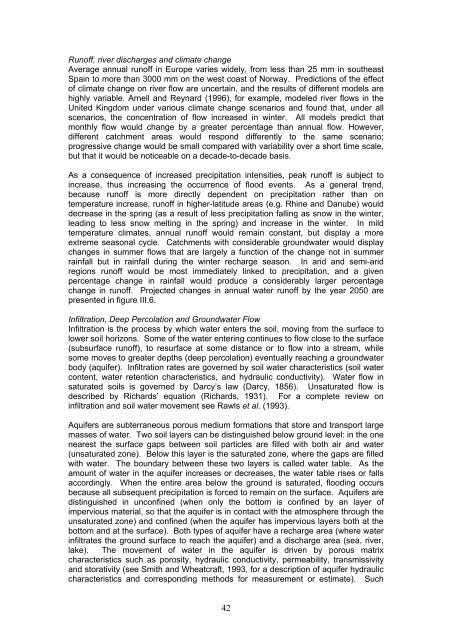Climate Change and the European Water Dimension - Agri ...
Climate Change and the European Water Dimension - Agri ...
Climate Change and the European Water Dimension - Agri ...
Create successful ePaper yourself
Turn your PDF publications into a flip-book with our unique Google optimized e-Paper software.
Runoff, river discharges <strong>and</strong> climate change<br />
Average annual runoff in Europe varies widely, from less than 25 mm in sou<strong>the</strong>ast<br />
Spain to more than 3000 mm on <strong>the</strong> west coast of Norway. Predictions of <strong>the</strong> effect<br />
of climate change on river flow are uncertain, <strong>and</strong> <strong>the</strong> results of different models are<br />
highly variable. Arnell <strong>and</strong> Reynard (1996), for example, modeled river flows in <strong>the</strong><br />
United Kingdom under various climate change scenarios <strong>and</strong> found that, under all<br />
scenarios, <strong>the</strong> concentration of flow increased in winter. All models predict that<br />
monthly flow would change by a greater percentage than annual flow. However,<br />
different catchment areas would respond differently to <strong>the</strong> same scenario;<br />
progressive change would be small compared with variability over a short time scale,<br />
but that it would be noticeable on a decade-to-decade basis.<br />
As a consequence of increased precipitation intensities, peak runoff is subject to<br />
increase, thus increasing <strong>the</strong> occurrence of flood events. As a general trend,<br />
because runoff is more directly dependent on precipitation ra<strong>the</strong>r than on<br />
temperature increase, runoff in higher-latitude areas (e.g. Rhine <strong>and</strong> Danube) would<br />
decrease in <strong>the</strong> spring (as a result of less precipitation falling as snow in <strong>the</strong> winter,<br />
leading to less snow melting in <strong>the</strong> spring) <strong>and</strong> increase in <strong>the</strong> winter. In mild<br />
temperature climates, annual runoff would remain constant, but display a more<br />
extreme seasonal cycle. Catchments with considerable groundwater would display<br />
changes in summer flows that are largely a function of <strong>the</strong> change not in summer<br />
rainfall but in rainfall during <strong>the</strong> winter recharge season. In arid <strong>and</strong> semi-arid<br />
regions runoff would be most immediately linked to precipitation, <strong>and</strong> a given<br />
percentage change in rainfall would produce a considerably larger percentage<br />
change in runoff. Projected changes in annual water runoff by <strong>the</strong> year 2050 are<br />
presented in figure III.6.<br />
Infiltration, Deep Percolation <strong>and</strong> Groundwater Flow<br />
Infiltration is <strong>the</strong> process by which water enters <strong>the</strong> soil, moving from <strong>the</strong> surface to<br />
lower soil horizons. Some of <strong>the</strong> water entering continues to flow close to <strong>the</strong> surface<br />
(subsurface runoff), to resurface at some distance or to flow into a stream, while<br />
some moves to greater depths (deep percolation) eventually reaching a groundwater<br />
body (aquifer). Infiltration rates are governed by soil water characteristics (soil water<br />
content, water retention characteristics, <strong>and</strong> hydraulic conductivity). <strong>Water</strong> flow in<br />
saturated soils is governed by Darcy’s law (Darcy, 1856). Unsaturated flow is<br />
described by Richards’ equation (Richards, 1931). For a complete review on<br />
infiltration <strong>and</strong> soil water movement see Rawls et al. (1993).<br />
Aquifers are subterraneous porous medium formations that store <strong>and</strong> transport large<br />
masses of water. Two soil layers can be distinguished below ground level: in <strong>the</strong> one<br />
nearest <strong>the</strong> surface gaps between soil particles are filled with both air <strong>and</strong> water<br />
(unsaturated zone). Below this layer is <strong>the</strong> saturated zone, where <strong>the</strong> gaps are filled<br />
with water. The boundary between <strong>the</strong>se two layers is called water table. As <strong>the</strong><br />
amount of water in <strong>the</strong> aquifer increases or decreases, <strong>the</strong> water table rises or falls<br />
accordingly. When <strong>the</strong> entire area below <strong>the</strong> ground is saturated, flooding occurs<br />
because all subsequent precipitation is forced to remain on <strong>the</strong> surface. Aquifers are<br />
distinguished in unconfined (when only <strong>the</strong> bottom is confined by an layer of<br />
impervious material, so that <strong>the</strong> aquifer is in contact with <strong>the</strong> atmosphere through <strong>the</strong><br />
unsaturated zone) <strong>and</strong> confined (when <strong>the</strong> aquifer has impervious layers both at <strong>the</strong><br />
bottom <strong>and</strong> at <strong>the</strong> surface). Both types of aquifer have a recharge area (where water<br />
infiltrates <strong>the</strong> ground surface to reach <strong>the</strong> aquifer) <strong>and</strong> a discharge area (sea, river,<br />
lake). The movement of water in <strong>the</strong> aquifer is driven by porous matrix<br />
characteristics such as porosity, hydraulic conductivity, permeability, transmissivity<br />
<strong>and</strong> storativity (see Smith <strong>and</strong> Wheatcraft, 1993, for a description of aquifer hydraulic<br />
characteristics <strong>and</strong> corresponding methods for measurement or estimate). Such<br />
42













